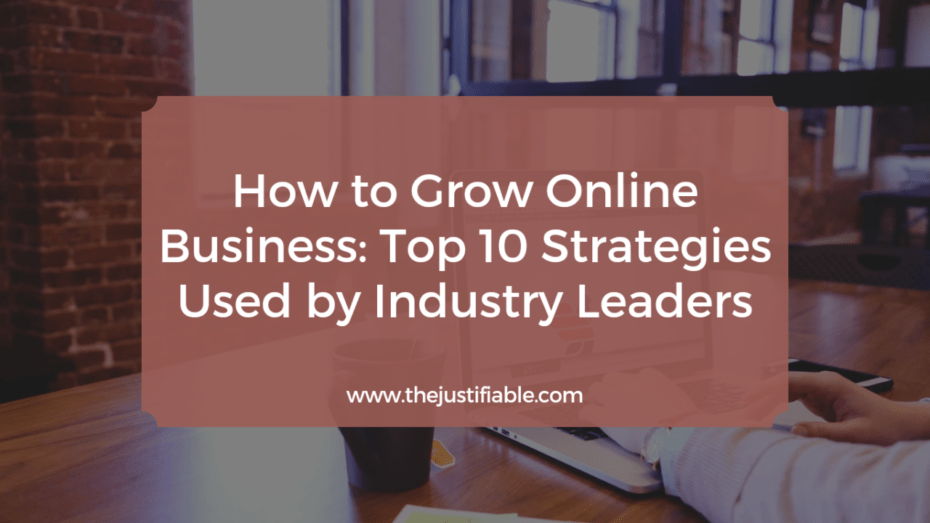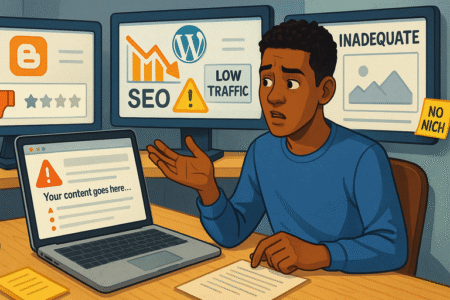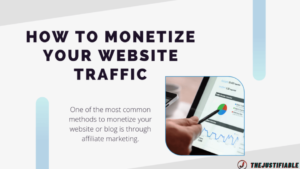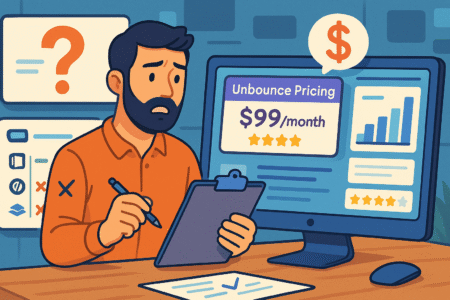Table of Contents
How to grow online business? As we progress further into the digital era, the online business landscape is growing and evolving at an unprecedented pace. Traditional brick-and-mortar stores have begun to adopt online platforms to reach a wider audience, and fully digital businesses are springing up daily.
From solo entrepreneurs to multinational corporations, businesses of all shapes and sizes are recognizing the immense potential that the online world offers. Knowing how to grow an online business has become a critical skill for today’s entrepreneurs.
The Internet breaks down geographical barriers, allowing businesses to reach potential customers on the other side of the globe. But with this global reach comes stiff competition. Thousands, if not millions, of businesses offer similar products or services, making the online marketplace incredibly saturated. In this environment, it is not just enough to establish an online presence; businesses must also know how to expand and thrive.
Understanding the Importance of Online Business Growth
The role of online business in the modern economy is undeniably significant. In a world where people are increasingly turning to the Internet for their needs – whether shopping, learning, working, or entertainment – businesses must meet their customers where they are. The Internet has changed consumer behavior, with online shopping becoming the norm rather than the exception.
Thus, the growth of an online business is not just about increasing sales or profits. It’s about survival and relevance in a rapidly changing commercial landscape. Businesses that fail to grow and adapt to these changes risk being left behind, while those that embrace them can capitalize on the vast opportunities the online world offers.
Effective growth strategies can have a profound impact on an online business. They can help businesses reach new customers, expand into new markets, and build a strong online presence. But beyond that, they can also foster customer loyalty, increase brand recognition, and even spark innovation. In short, growing an online business is not a one-off task; it’s an ongoing process that requires a comprehensive and well-planned strategy.
It’s clear that understanding how to grow an online business is more crucial than ever. In the following sections, we will explore the top 10 strategies used by industry leaders to achieve this growth, offering insights and practical tips to help you on your online business journey.
Strategy 1: SEO (Search Engine Optimization)
In understanding how to grow an online business, one cannot overlook the importance of Search Engine Optimization (SEO). SEO plays a crucial role in ensuring that your business is visible to potential customers. Without it, even the best products or services risk getting lost in the sea of online content.
The Role of SEO in Growing an Online Business
When users search for a product or service online, they typically click on the first few results that appear on their search engine results page (SERP). SEO is the practice of optimizing a website so that it ranks higher in these results, increasing its visibility and the likelihood that users will visit the site.
SEO is essential for online business growth for several reasons. First, it increases organic traffic to your website. Organic traffic, or visitors who come to your website as a result of unpaid search results, are often more targeted and thus more likely to convert into customers.
Secondly, SEO builds trust and credibility. Websites that appear higher in search results are generally perceived as more trustworthy and credible, enhancing your brand’s reputation.
Moreover, SEO provides valuable insight into your customers. By analyzing the keywords that bring users to your website, you can better understand what your customers are looking for and adjust your offerings accordingly.
Best SEO Practices to Follow
Growing your online business using SEO involves several key practices.
- Keyword Research: This is the process of identifying the words and phrases that potential customers use when searching for your products or services. Incorporating these keywords into your website’s content can help improve its ranking.
- On-Page SEO: This involves optimizing individual web pages on your site. This includes not just the content but also the HTML source code. Elements like meta tags, title tags, and headers should all be optimized for your target keywords.
- Off-Page SEO: This refers to activities conducted outside of your own website to improve its search engine rankings, such as backlink building. High-quality backlinks from reputable websites signal to search engines that your content is valuable, helping to improve your site’s ranking.
- User Experience: Search engines favor websites that provide a positive user experience. This includes factors like page load speed, mobile responsiveness, and easy navigation.
- Content Creation: Regularly creating high-quality, original content that provides value to your users is crucial. This not only helps to improve your website’s SEO but also establishes your business as a leader in your field.
Strategy 2: Social Media Marketing
Harnessing the power of social media has become a crucial aspect in figuring out how to grow an online business. As platforms where billions of people worldwide connect and share content daily, social media presents significant opportunities for businesses to engage with audiences and drive growth.
The Power of Social Media in Boosting Online Business
Social media plays a pivotal role in boosting online businesses in several ways. Firstly, it significantly broadens your reach. Platforms such as Facebook, Instagram, Twitter, and LinkedIn have millions, even billions, of active users who can potentially come across your brand.
Secondly, social media provides platforms for direct communication with your audience. It’s a space where businesses can not just promote their products or services, but also engage with customers on a personal level. This engagement helps build relationships, foster brand loyalty, and gather valuable feedback.
Furthermore, social media can drive traffic to your website. By sharing content that links back to your site, you can guide social media users to learn more about your business, products, or services, potentially leading to conversions.
Lastly, social media allows you to learn more about your audience. Platforms provide valuable data on user demographics and behavior, which can inform your marketing strategy and help you deliver more targeted, effective messages.
Tips on Effective Social Media Marketing
To leverage social media effectively in growing your online business, here are some tips to keep in mind:
- Understand Your Audience: Different social media platforms attract different demographics. Understand where your target audience spends their time online and focus your efforts on those platforms.
- Create Engaging Content: Social media is all about engagement. Create posts that are not only visually appealing but also invite interaction, such as questions, polls, or user-generated content prompts.
- Use Hashtags: Hashtags can increase the visibility of your content to people who don’t already follow you. Research popular and relevant hashtags to include in your posts.
- Leverage Influencers: Influencer marketing can be a powerful tool on social media. Collaborating with influencers who align with your brand can help you reach a larger and more engaged audience.
- Monitor and Respond to Comments: Social media is a two-way street. Don’t just post content—engage with your followers by responding to comments and messages. This shows customers you value their input and helps build strong relationships.
- Analyze and Adapt: Use analytics tools to track the success of your social media marketing efforts. Review your performance regularly and adjust your strategy based on what’s working and what isn’t.
Implementing an effective social media marketing strategy can significantly boost your online business, turning social media users into website visitors, leads, and ultimately, customers.
Strategy 3: Content Marketing
In the quest to learn how to grow an online business, content marketing is a vital strategy. This method involves creating and sharing valuable content to attract, engage, and retain an audience, ultimately leading to profitable customer action.
How to Leverage Content Marketing to Engage and Retain Customers
Content marketing works on the premise that by providing your audience with valuable, relevant content, you can build trust and establish a strong relationship with them, making them more likely to choose your business when they’re ready to make a purchase.
The first step to leveraging content marketing is to know your audience. Understand their needs, interests, and challenges. This will allow you to create content that addresses those areas and truly resonates with them.
Next, deliver your content through the channels where your audience is most active. This might be your website’s blog, email newsletters, or even social media platforms.
Remember, the goal of content marketing is not to sell, but to engage. Rather than pushing your products or services, focus on providing value, whether that’s in the form of information, entertainment, or inspiration. This will help you build a loyal audience that trusts and respects your brand.
Lastly, make sure to regularly engage with your audience. Respond to comments, ask for feedback, and show appreciation for their support. This will help foster a sense of community and keep your audience coming back for more.
Strategies for Developing Compelling Content
Creating compelling content that stands out from the competition is key to a successful content marketing strategy. Here are some strategies to help you achieve this:
- Understand Your Audience’s Needs: The best content is that which addresses your audience’s specific needs, questions, or challenges. Use tools like surveys, customer interviews, and social listening to understand what your audience wants to know.
- Use Storytelling: Stories are a powerful way to engage your audience and make your content more memorable. Try to weave narratives into your content, whether that’s the story of your company, your customers, or the impact of your products or services.
- Incorporate Visuals: Visual content, like images, infographics, or videos, can make your content more engaging and easier to digest. Whenever possible, use visuals to complement your written content.
- Create Actionable Content: Content that provides practical, actionable tips is highly valuable to audiences. Try to include clear, step-by-step instructions or advice in your content.
- Stay Up-to-Date: The online world is constantly evolving, and what interests your audience can change quickly. Stay up-to-date with trends and current events to ensure your content remains relevant and engaging.
Strategy 4: Email Marketing
In the landscape of digital marketing, one might assume that email marketing has lost its shine. However, when contemplating how to grow an online business, ignoring email marketing would be a mistake.
Despite the rise of social media and other marketing channels, email remains one of the most effective ways to reach and engage with your audience.
The Importance of Email Marketing in Maintaining Customer Relationships
Email marketing plays a significant role in maintaining and enhancing customer relationships. It provides a direct line of communication to your customers, allowing you to deliver personalized messages right to their inbox. This can foster a sense of connection and loyalty, making customers feel valued and appreciated.
Moreover, email marketing can help keep your business at the top of customers’ minds. By regularly providing valuable content, updates, and offers through email, you can ensure your business remains relevant and enticing to your audience.
Additionally, email marketing is incredibly cost-effective. It allows you to reach a large number of people at a relatively low cost, making it a particularly valuable tool for small or growing businesses.
Lastly, the data and insights gained from email marketing can be invaluable in refining your marketing strategy. You can track open rates, click-through rates, and conversions to better understand what content resonates with your audience and how you can improve your approach.
Techniques for Effective Email Marketing Campaigns
Here are some tried and tested techniques to ensure your email marketing campaigns effectively contribute to your online business growth:
- Segmentation: Segment your email list based on factors like purchase history, location, and behavior. This allows you to send more personalized and relevant emails, which are more likely to resonate with your audience.
- Subject Lines: An enticing subject line can significantly increase your open rates. Keep it short, engaging, and relevant to the content of the email.
- Quality Content: The content of your emails should provide value to the recipient, whether that’s in the form of useful information, exclusive offers, or entertaining content.
- CTAs: Always include a clear call to action (CTA) in your emails. This guides the recipient on what action they should take next, be it visiting your website, purchasing a product, or reading a blog post.
- Test and Analyze: Regularly test different aspects of your emails, like subject lines, content, and layout. Analyze the results to understand what works best for your audience and continually improve your strategy.
Strategy 5: Influencer Marketing
In the context of understanding how to grow an online business, a modern and highly effective strategy is influencer marketing. This method leverages the popularity and reach of influencers – individuals with large and engaged followings on social media – to promote your brand and products.
Exploring the Impact of Influencer Marketing
Influencer marketing can have a powerful impact on your online business. Influencers have an established and trusting relationship with their followers. When they recommend a product or service, their followers are more likely to trust that recommendation and view your brand favorably.
Moreover, influencers can significantly broaden your reach. By collaborating with an influencer, you gain access to their large and engaged audience, many of whom may not have known about your brand otherwise.
Influencer marketing can also enhance your brand image. When a popular and respected influencer associates with your brand, it elevates your brand’s perceived value and appeal.
Finally, influencer-generated content can be a valuable addition to your content strategy. The photos, videos, and testimonials that influencers create for your brand can be reused on your own social media platforms, website, or email newsletters, providing authentic and engaging content.
How to Choose the Right Influencers for Your Online Business
The key to successful influencer marketing lies in choosing the right influencers to collaborate with. Here are some factors to consider:
- Relevance: The influencer’s niche or field should align with your brand. Their followers should be people who would likely be interested in your product or service.
- Authenticity: Choose influencers who are genuine and authentic. Their endorsements should come across as trustworthy and not overly promotional.
- Engagement: Look at the influencer’s engagement rate, not just their follower count. An influencer who frequently interacts with their followers and receives plenty of likes, comments, and shares is likely to have a more engaged and attentive audience.
- Values: Ensure the influencer’s values align with those of your brand. This consistency will make the collaboration feel more authentic and appealing to the audience.
- Track Record: Look at the influencer’s past collaborations. Have they worked with other brands in your industry? What was the outcome?
Remember, the most effective influencers are not always those with the largest followings. Sometimes, micro-influencers with smaller but highly engaged audiences can deliver even better results.
Strategy 6: Paid Advertising
If you’re wondering how to grow an online business quickly and efficiently, investing in paid advertising can be a viable strategy. With an array of platforms and targeting options available, paid advertising can help you reach a larger audience and drive more traffic and conversions for your business.
The Role of Paid Advertising in Reaching a Larger Audience
Paid advertising plays a significant role in digital marketing by enabling businesses to reach a larger, more targeted audience than they could organically. Unlike organic methods that require time and consistency to build an audience, paid advertising can provide immediate visibility and results.
One of the key benefits of paid advertising is the ability to precisely target your audience. Most platforms offer sophisticated targeting options that allow you to reach people based on their demographics, interests, behavior, and more. This ensures that your ads are seen by the people who are most likely to be interested in your product or service.
Moreover, paid advertising can give you a competitive edge. If your competitors are investing in paid advertising and you’re not, you may find it difficult to cut through the noise and get your brand noticed.
Finally, paid advertising can provide valuable data and insights. By analyzing your ad performance, you can gain a better understanding of your audience and what messages resonate with them, informing your overall marketing strategy.
Choosing the Right Platforms for Paid Advertising
When investing in paid advertising, choosing the right platform is crucial. Here are some factors to consider:
- Audience: Understand where your target audience spends their time online. Different platforms attract different demographics, so you want to ensure your ads are appearing where your audience is most likely to see them.
- Goal: What are you trying to achieve with your ads? Different platforms may be better suited to different goals. For example, Google Ads can be highly effective for driving traffic and conversions, while Facebook can be great for building brand awareness and engagement.
- Budget: Different platforms have different pricing structures. Consider your budget and the potential return on investment each platform can offer.
- Content: The type of content you’re promoting can also influence which platform is best. For example, if you have visually appealing products, platforms like Instagram or Pinterest might be a good fit.
Strategy 7: User Experience (UX) Optimization
As you discover how to grow an online business, it’s critical not to overlook the importance of user experience (UX) optimization. This strategy focuses on making your website or app easy to use, enjoyable, and effective at meeting the user’s needs.
Why UX is Crucial for Online Business Growth
A positive user experience is integral to online business growth for several reasons. Firstly, it directly impacts your conversion rate. If visitors find your website easy to navigate, they are more likely to stay, explore, and eventually make a purchase.
Secondly, UX impacts your search engine ranking. Search engines like Google consider user experience indicators, such as page load speed and mobile-friendliness, in their ranking algorithms. By optimizing UX, you can boost your SEO and increase your online visibility.
Thirdly, a good user experience can enhance customer satisfaction and loyalty. If users enjoy interacting with your website or app, they are more likely to return and recommend your business to others, resulting in increased customer retention and word-of-mouth referrals.
Lastly, UX optimization can help you stand out from the competition. In a digital world where customers have endless options at their fingertips, providing a superior user experience can give you a competitive edge.
Best Practices for Optimizing UX
When optimizing UX, it’s essential to put the user at the center of your design process. Here are some best practices to guide you:
- Simplicity: Keep your design clean and straightforward. Ensure it’s easy for users to find what they’re looking for and navigate your site.
- Speed: Ensure your pages load quickly. Slow load times can frustrate users and lead them to abandon your site.
- Responsiveness: Make sure your website is mobile-friendly. With more and more people browsing the web on their phones, a site that’s not optimized for mobile can provide a poor user experience.
- Accessibility: Your website should be accessible to all users, including those with disabilities. This includes considerations like color contrast, font size, and site navigation.
- Personalization: If possible, personalize the user experience. This might include personalized product recommendations or content based on the user’s browsing history or preferences.
- User Testing: Regularly test your website with real users to get feedback and identify any issues or areas for improvement.
Strategy 8: Analytics and Data-Driven Decisions
Learning how to grow an online business invariably involves harnessing the power of data. In the digital age, businesses have access to a wealth of data that can guide their decision-making and fuel their growth—if used effectively.
Understanding the Importance of Data in Decision Making
Data plays a crucial role in online business growth. It provides a foundation upon which to build strategies, gauge performance, and make informed decisions. By analyzing data, businesses can gain insights into customer behavior, market trends, and the effectiveness of their marketing efforts.
For instance, data can reveal which marketing channels are driving the most traffic, what products are most popular, or where visitors are dropping off your website. This information can guide your strategies and help you allocate resources more effectively.
Furthermore, data allows for continuous improvement. By regularly analyzing your performance data, you can identify areas for improvement, test different approaches, and optimize your strategies based on what works best.
Data also facilitates personalization—a key element of modern marketing. By understanding individual customer behaviors and preferences, you can tailor your marketing messages and offers to increase their relevance and effectiveness.
Finally, data can give you a competitive edge. By keeping a pulse on market trends and customer sentiment, you can stay ahead of the competition and quickly adapt to changes in the market.
Tools and Techniques for Effective Data Analysis
To effectively harness the power of data, businesses need to employ the right tools and techniques. Here are some to consider:
- Google Analytics: This tool is a must for any online business. It provides comprehensive data about your website’s performance, including visitor demographics, behavior, and conversion data.
- Social Media Analytics: Platforms like Facebook, Instagram, and Twitter have built-in analytics tools that provide insights into your social media performance.
- CRM Software: Customer Relationship Management (CRM) software can provide valuable data about your customers and their interactions with your business.
- A/B Testing Tools: Tools like Optimizely or Google Optimize allow you to test different versions of your website or marketing materials to see which performs better.
- Data Visualization Tools: Tools like Tableau or PowerBI can help you visualize your data in a more digestible format, making it easier to interpret and act upon.
When it comes to data analysis, it’s not just about having the right tools—it’s also about asking the right questions. Start with clear objectives and key performance indicators (KPIs) to guide your analysis and ensure your data efforts are aligned with your business goals.
Strategy 9: Affiliate Marketing
As you’re exploring ways on how to grow an online business, don’t overlook the potential of affiliate marketing. This strategy involves partnering with affiliates—individuals or companies who promote your products in exchange for a commission on the sales they generate.
How Affiliate Marketing Can Help Grow an Online Business
Affiliate marketing can contribute to your online business growth in several ways. Here’s how:
- Extended Reach: Affiliates can help you reach potential customers you might not have been able to reach on your own. They can promote your products to their established audiences, extending your reach and visibility.
- Cost Efficiency: Affiliate marketing operates on a performance-based model, meaning you only pay a commission when a sale is made. This makes it a cost-effective strategy with a high return on investment.
- Brand Trust: Affiliates, particularly influencers or industry experts, often have a level of trust with their audience that can translate to trust in your brand.
- SEO Benefits: If affiliates link back to your website in their content, it can boost your SEO by increasing your site’s backlink profile.
- Market Insights: Affiliates can provide valuable insights about your target market and feedback on your products, which you can use to improve your offerings.
Steps to Set Up a Successful Affiliate Marketing Program
Here are some steps to set up a successful affiliate marketing program:
- Identify Your Goals: Before you start, define what you want to achieve with your affiliate program. Are you looking to increase sales, website traffic, brand awareness, or something else?
- Choose the Right Affiliates: Look for affiliates who have a relevant audience and align with your brand values. They should be reputable, reliable, and have a good engagement rate.
- Set Clear Terms and Conditions: Be clear about your commission structure, payment terms, and any rules or guidelines affiliates should follow.
- Provide Support: Provide your affiliates with the tools and resources they need to succeed, such as promotional materials, product information, and training.
- Track and Optimize: Use affiliate marketing software to track your affiliates’ performance, pay commissions, and gain insights that can help you optimize your program.
Strategy 10: Customer Service and Engagement
As you explore how to grow an online business, remember that your customers are your most important asset. Excellent customer service and engagement not only foster customer satisfaction and loyalty but can also significantly boost your business growth.
The Role of Customer Service in Online Business Growth
Customer service plays a pivotal role in online business growth in several ways:
- Customer Retention: It’s often more cost-effective to retain existing customers than to acquire new ones. By providing exceptional customer service, you can increase customer satisfaction and loyalty, leading to repeat business.
- Brand Reputation: Great customer service can enhance your brand’s reputation. Satisfied customers are more likely to recommend your business to others, leading to word-of-mouth referrals.
- Competitive Advantage: In a market saturated with competitors, excellent customer service can set you apart. Customers are often willing to pay more for a better service experience.
- Customer Lifetime Value: By delivering outstanding customer service, you can increase the customer lifetime value (CLV). Satisfied customers are likely to continue doing business with you over time and become more valuable as a result.
Effective Strategies for Customer Engagement
Engaging with customers is crucial for maintaining a strong relationship with them. Here are some strategies to boost customer engagement:
- Personalization: Personalize your interactions with customers. Use their name in communications, and offer personalized recommendations based on their preferences or past purchases.
- Regular Communication: Maintain regular communication with customers through newsletters, social media updates, or personalized emails. Just ensure you’re providing value, not just selling.
- Interactive Content: Use interactive content like quizzes, polls, or contests to engage your audience and create a two-way interaction.
- Customer Surveys and Feedback: Ask for customer feedback regularly. Not only does this make customers feel valued and heard, but it can also provide you with valuable insights.
- Customer Communities: Consider creating a customer community, such as a Facebook group or a forum on your website, where customers can connect with each other and your brand.
- Superior Support: Offer various ways for customers to get support, such as live chat, email, and phone. Make sure your support team is responsive and helpful.
Conclusion
Learning how to grow an online business involves implementing a variety of strategies that encompass different aspects of the digital marketing sphere. Each strategy has its unique benefits, and their effectiveness can often be enhanced when used together.
From SEO to content marketing, social media to email marketing, and beyond, these strategies aim to increase your online visibility, engage with your audience, and ultimately drive sales. But beyond these strategies, the heart of any successful online business is providing excellent customer service and ensuring a positive user experience.
As the digital landscape continues to evolve, it’s crucial to stay up-to-date with the latest trends and strategies for online business growth. Continual learning and adaptation are key to navigating the dynamic world of online business.
Remember, success doesn’t typically happen overnight. Patience, persistence, and consistency are key. Measure your progress, learn from your data, and adjust your strategies as needed. Over time, you’ll learn what works best for your unique business and audience.






